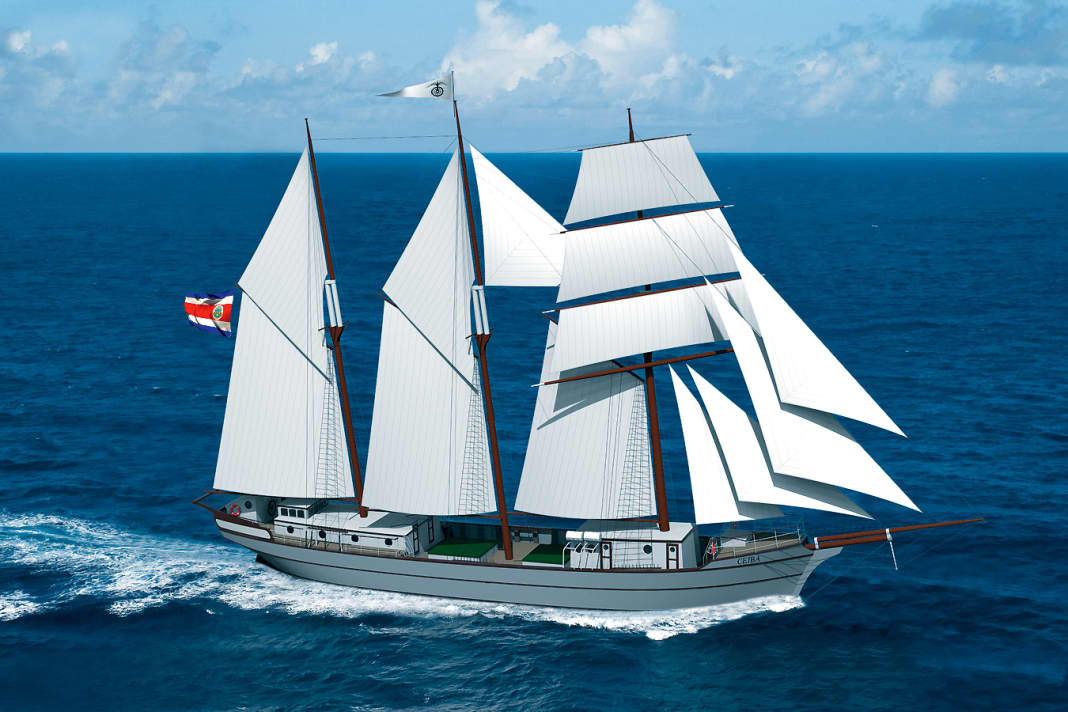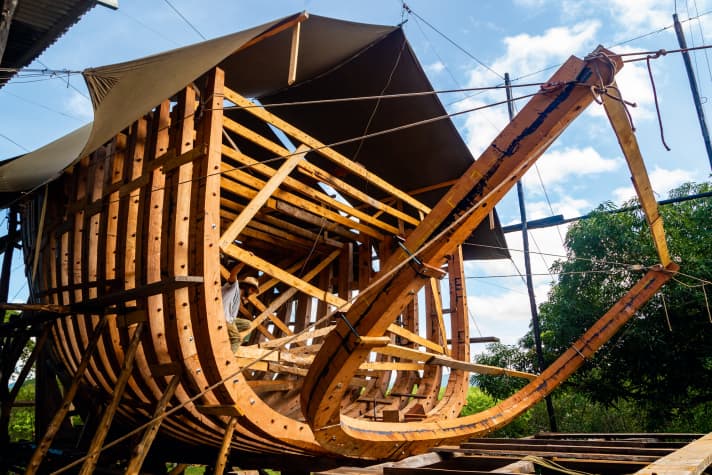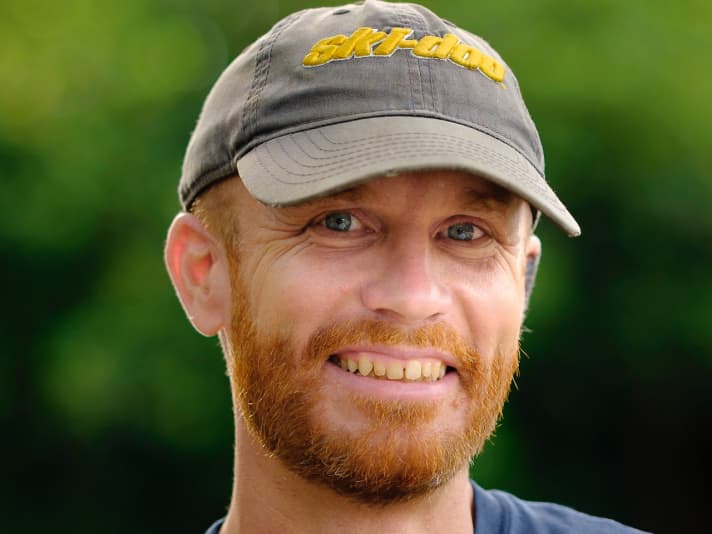Cargo ship "Ceiba": How the largest wooden cargo ship is being built in Costa Rica
Morten Strauch
· 09.05.2023






Leaving the famous Panamericana motorway, Route 132 winds its way through sparsely populated areas. After a few kilometres, it ends on a densely wooded headland at a loading bridge for sugar cane. The Gulf of Nicoya stretches out in front of it. It is located in the north-west of Costa Rica, on the Pacific coast of the small Central American state. Just before the end of Route 132 is the entrance to the Astillero Verde (green shipyard) site. It is easy to miss; Gesa Thönnessen drives past it twice. Only a small sign indicates that here, in the middle of the mangrove forests, a vision is being promoted that not only aims to achieve emission-free maritime trade, but also pursues a holistic approach to sustainability.
Thönnessen is Managing Director of the German ship chandler Toplicht. She is currently in Costa Rica, her "second home", as she says. She spent a year in the country in 2004/05. As she was in business contact with the green shipyard founded by the Sailcargo initiative some time ago, she took the opportunity to take a look at the three-masted schooner "Ceiba" currently under construction there. Thönnessen knows a thing or two about traditional ships. She has heard a lot about the supposed lighthouse project, which, judging by the pictures on the website, appears to be run by a hip drop-out community. She doesn't know what the real situation is in times of post-corona, energy and material crises.
The goal: to build the largest wooden sailing cargo ship in the world
What immediately catches the eye is that the boat builders not only work on the shipyard site, they also live there. The camp wakes up at six in the morning, accompanied by crowing roosters, singing birds of paradise and loud howler monkeys. Half an hour later, the first shift begins. Due to the tropical climate, every minute of working time is valuable before the sun makes the temperatures climb to sweat-inducing heights.
The initiative's mission: to build the world's largest wooden sailing cargo ship, which will transport goods across the Pacific in a 100% climate-neutral way. Specialists from all over the world are involved, who are not only passionate about their project, but are also prepared to put up with the spartan accommodation in tents and tree houses in addition to the heat and humidity. Before anyone gets the idea: trainees or unskilled volunteers from abroad are no longer accepted.
"Their familiarisation turned out to be too time-consuming, it simply takes up too much time," explains Lynx Guimond. He is the technical manager of the project (see interview below ). On this day, he takes time to show the visitor from Germany the shipyard and the ship. However, it is not just professionals who work here. It is important to the initiators that at least half of the helpers are Costa Rican.
"Fitzcarraldo" at the cinema evening in the Urwald shipyard
As archaic as the building site and the still unfinished hull of the "Ceiba" may seem, the work steps on the ship are professionally synchronised. Despite the sometimes tough jobs that have to be done, the atmosphere in the team is remarkably friendly. German photographer Verena Brüning confirms this. She lived on the site for a month to document the project. Brüning: "At the weekends, we go on beach trips or motorbike tours. Once we even improvised a cinema evening to watch the classic film 'Fitzcarraldo' together in a jungle setting." The film in which an eccentric Klaus Kinski drives a steamboat through the Amazon jungle under tremendous hardship.
With our relatively small cargo sailing ships, we are breaking away from a market that has failed our environment"
Things at the shipyard are not quite as dictatorial as under Kinski. Discipline is nevertheless at the top of the agenda, along with work safety. For example, steel-toed shoes and safety belts are obligatory here. The food is cooked by local women and some of the ingredients come from the company's own permaculture garden. As if that wasn't enough, waste is recycled and even the sewage is processed and sold to the farmers as fertiliser. Sustainability is not just an empty PR phrase here. Even in Costa Rica, the model country for eco-tourism, this holistic concept is unrivalled.
It began in 2019 with a keel made from tamarind trunks
Construction of the "Ceiba" began in January 2019 with the laying of the keel: Three massive tamarind trunks that had been uprooted by a hurricane were transported from the north of the country to the shipyard, which had just been completed at the time. A lot has happened since then. 56 heavy frames, erected by hand with a pulley and fixed in their respective positions, form the skeleton of the ship. The interior panelling has been completed and the galley has been built on deck. Work is currently underway on the exterior planking, and the rudders and masts are on the agenda for this year.

The wood from around 400 trees, including Sitka spruce, Spanish cedar and jatoba, is needed to complete the maritime structure. Due to Costa Rica's strict laws, the trees have to be reforested. Sailcargo has set up a non-profit organisation for this purpose, which plants 25 new trees for every one felled.
The 'Ceiba' looks like a cathedral"
Gesa Thönnessen is impressed after her tour: "Standing in front of this huge ship, which was built with so much love and sweat, made me very emotional," she reports. "The 'Ceiba' looks like a cathedral whose builders have thought about every last detail."
War and corona fuelled interest in sustainability
Surprisingly, neither the coronavirus pandemic nor the supply chain and energy problems exacerbated by the war in Ukraine have stopped the project. "On the contrary," says Lynx Guimond, "many companies were so frustrated by their dependencies that they suddenly showed an increased interest in sustainable and resilient services. Gradually, Sailcargo moved into the international spotlight, so that more potential customers and investors sought direct contact with us."
The 46-metre-long ship is due to set sail in 2025 to transport organic goods such as coffee and cocoa along the Pacific coast from South to North America. The "Ceiba" will be able to carry 250 tonnes of freight, which corresponds to around nine container loads. By comparison, the largest container ship in the world can load 24,000 of the steel boxes. It would take a fleet of 2,667 "Ceiba"-class cargo ships to move the same amount.
A small fleet of sailing cargo ships is to be created
The founders of Sailcargo know that they cannot change the world in one fell swoop. Guimond: "We have started procuring materials for a second ship, but we are also planning to purchase existing sailing ships such as our recently acquired 'Vega' from Sweden." The aim is to operate a small fleet of sailing cargo ships. "The 'Ceiba' is intended to show what is possible. It is just one part of our larger vision."
The fact is that around 90 per cent of global goods traffic takes place by sea. Merchant shipping is responsible for almost three per cent of global CO2 emissions. In addition, ship engines are usually fuelled with toxic heavy fuel oil. The International Maritime Organisation has set the target of reducing emissions by 50 percent by 2050 compared to 2008. However, this is not enough for the boat builders in Costa Rica.
When Gesa Thönnessen finishes her visit to the shipyard that day, gets into her car, drives off the site and turns onto Route 132, she is not only impressed by the immense complexity of the project. But also by the amount of positive energy with which it is being tackled. Full of admiration, she says: "It's great that there are such visionary people who have set their sails on a zero-emissions course in these times."
Technical data "Ceiba"
- Total length:46 m
- Width: 8 m
- Depth:4,30 m
- Height of main mast above waterline: 33,50 m
- sail area: 580 m²
- Number of sails: 14
- Crew/guests: 12/12 pers.
- Motor: electric, approx. 400 hp
- Freight capacity: 250 t
"Ship goods more intelligently!" - Interview with designer Lynx Guimond

YACHT: Mr Guimond, how did the idea of building the world's largest sailing cargo ship out of wood come about?
Lynx Guimond:Danielle Doggett, who later became our CEO, and I got to know each other when we were travelling as sailors on other sailing cargo ships in Europe. In 2014, together with John Porras, our current construction manager, we had the idea of launching a larger boat. This would allow us to operate an economically viable goods transport service in America, where there are no sailing cargo ships that offer such a service.
And why are you building the ship in Costa Rica?
With its strict environmental laws, its social development and its access to sustainable, high-quality wood, Costa Rica is predestined for the construction of wooden ships.
Do you believe that you can really change global freight shipping with your project?
Every movement begins with a first step. We don't expect to turn the entire industry upside down. But by offering an alternative, we can show that the demand for sustainable transport services is there. Our biggest customer imports 500 containers of coffee every year. We can transport 20 per cent of this every year with zero emissions. And that's with just two ships! This example alone shows the enormous potential that we can offer small to medium-sized companies to effectively reduce the emissions generated during the transport of their products.
What else do you think needs to happen to decarbonise freight shipping?
Shipping fewer goods and then shipping them more intelligently. The amount of unnecessary products and empty ships travelling around the world is astonishing. If there were also subsidies that would reduce the cost of local products compared to cheaper imported goods, the respective population could consciously make sustainable choices without their budget playing a role.

